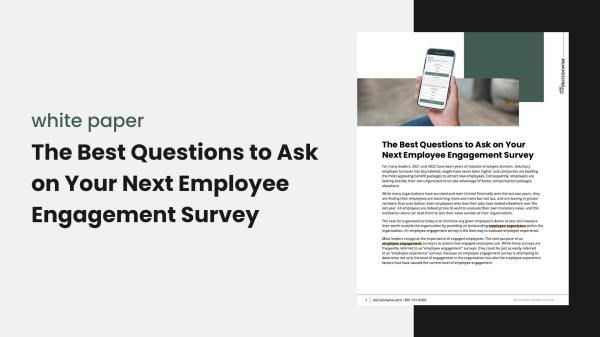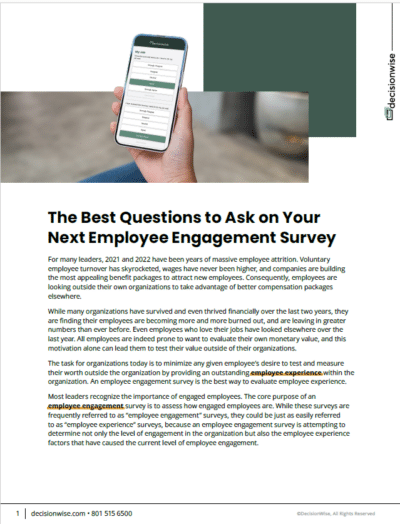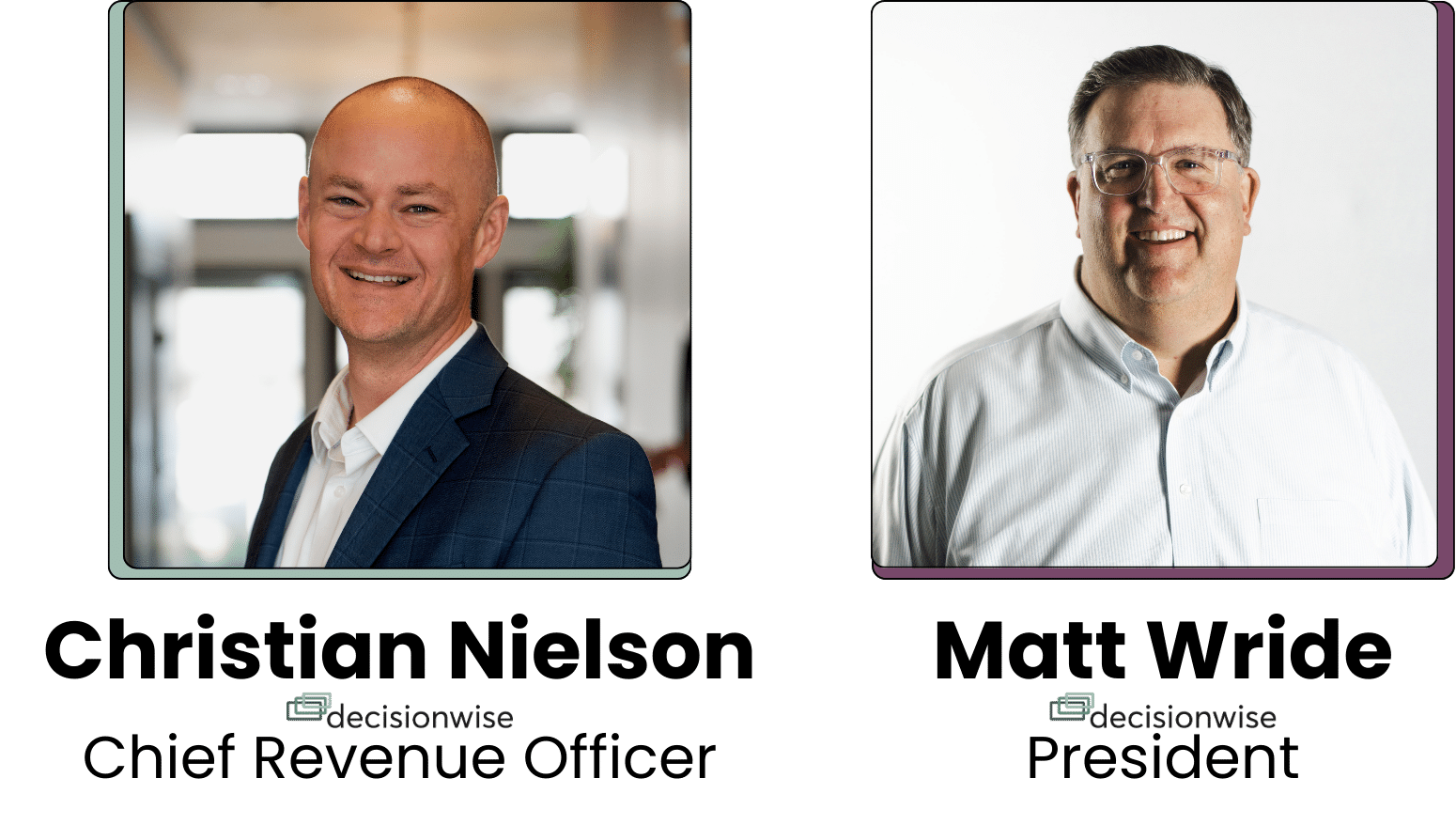For many leaders, 2021 and 2022 have been years of massive employee attrition. Voluntary employee turnover has skyrocketed, wages have never been higher, and companies are building the most appealing benefit packages to attract new employees. Consequently, employees are looking outside their own organizations to take advantage of better compensation packages elsewhere.
While many organizations have survived and even thrived financially over the last two years, they are finding their employees are becoming more and more burned out, and are leaving in greater numbers than ever before. Even employees who love their jobs have looked elsewhere over the last year. All employees are indeed prone to want to evaluate their own monetary value, and this motivation alone can lead them to test their value outside of their organizations.
The task for organizations today is to minimize any given employee’s desire to test and measure their worth outside the organization by providing an outstanding employee experience within the organization. An employee engagement survey is the best way to evaluate employee experience.
Most leaders recognize the importance of engaged employees. The core purpose of an employee engagement survey is to assess how engaged employees are. While these surveys are frequently referred to as “employee engagement” surveys, they could be just as easily referred to as “employee experience” surveys, because an employee engagement survey is attempting to determine not only the level of engagement in the organization but also the employee experience factors that have caused the current level of employee engagement.
In fact, while we often conflate employee engagement and employee experience, they are two distinct concepts. Employee engagement is the desired result of a positive employee experience. Surveys should be comprehensive enough to understand the entire employee experience, allowing us to analyze the results and determine the next best steps.
The best employee engagement survey questions will include the following five key components:
- Direct Measure of Employee Engagement
- Employee Engagement Drivers
- Questions Addressing Employee Engagement
- Open-Ended Comment Questions
- A Selection of Other Key Metrics for Your Organization
Direct Measure of Employee Engagement
A direct measure of engagement serves as the foundation for any employee engagement survey. We use engagement anchor questions to determine whether employees are engaged or disengaged. Each survey contains five or six questions designed to assess employee experience outcomes. These survey items are not directly actionable. They are intended to help us understand each employee’s overall experience. The following survey items, presented with a 5-point agreement scale, are examples:
- Overall, I love my job
- Time passes quickly while I am at work
- It is easy to become engaged in my work
As you can imagine, addressing these items directly would be very difficult. To change employee perceptions of these items, the organization must address specific aspects of the employee experience. The advantage of this type of question is that you can use the combined score of these items as the basis for analysis. Individual employees, for example, could be classified into groups based on their responses to these items. Those who scored these items very favorably would be classified as engaged, and those who scored them very unfavorably as disengaged. Others are more tepid but generally positive, and still, others are completely neutral.
We can now examine each of those groups separately and assess the results of the rest of the survey for each isolated group. From there, we can answer questions like, “What aspects of the employee experience are our engaged employees most pleased with?” or, perhaps more importantly, “what aspects of the employee experience are our disengaged employees most critical of?”
Additionally, the combined responses to engagement anchor questions can be used as a dependent variable in multiple regression analysis, where we can understand what factors in the employee experience might be driving people to be engaged or disengaged.
Drivers of Employee Engagement
Drivers of employee engagement can be determined through multiple regression analysis. The best employee engagement survey questions are designed to measure many factors related to the employee experience. Some of those factors directly lead people to be engaged, other factors may only lead people to be satisfied.
Many years ago, employee surveys were more commonly referred to as “employee satisfaction surveys.” These surveys were designed to better understand the transactional side of the employer/employee relationship. Satisfaction surveys asked about employee feelings around compensation, benefits, workload, stress, safety, tools, training, and resources. Questions about employee satisfaction are still considered to be important.
Engagement surveys are designed to understand the employee experience at a deeper level. Engagement drivers are meant to determine what causes a person to connect with their organizations and their work in a way that leads to a deeper level of commitment and a willingness to give more effort, creativity, time, and passion to their work.
We have conducted extensive research and have years of experience to know what items to include in a survey in order to understand why employees commit on a deeper level. The DecisionWise Engagement MAGIC framework is a good starting point when developing employee engagement training. Engagement MAGIC provides five factors that have been shown over a large data set, including thousands of organizations from many different industries that lead to engagement. All five factors are defined below, along with a sample question for each:
- Meaning: The feeling that your work has purpose beyond the day-to-day tasks you perform
Sample question: My job provides me with a sense of meaning and purpose. - Autonomy: The power to shape your work and environment in ways that allow you to perform at your best
Sample question: I have the freedom to decide how best to do my job. - Growth: Being challenged and stretched in ways the result in personal and professional progress
Sample question: My work gives me opportunities to learn and grow. - Impact: Seeing positive, effective, and worthwhile outcomes and results from your work
Sample question: “Most days, I feel like I am making progress on important work projects or initiatives. - Connection: The sense of belonging to something beyond yourself
Sample question: “I feel like I belong here.”
Employees are much more likely to engage in their work when they feel their work has purpose, that they are contributing meaningfully, that the organization trusts them to complete their tasks using their best judgment, that they are making professional progress, and that they feel a sense of belonging.
The Engagement MAGIC elements are not the only items that show up as drivers for every individual organization. Each organization is distinct. It is still important to examine the survey data as a whole. To understand what drives engagement from one organization to the next, it is still necessary to run regression analysis on each data set. Engagement MAGIC is a great place to start when it comes to survey design. Several of these elements are very likely, if not certain, to appear as drivers in your organization.
Questions Addressing Employee Satisfaction Elements
Effective employee engagement survey questions, as previously stated, will go beyond engagement and engagement drivers. Employee satisfaction remains an important component of employee morale and will largely determine whether or not your employees are willing to stay with your organization. Employee satisfaction factors, while not as deep and transformative as engagement drivers, are an important component of the employee experience. For example, having the necessary tools and resources to do your job will not cause you to wake up in the morning thinking, “I can’t wait to get to work.” However, if you know you don’t have the tools you need to do your job on a regular basis, it could be the source of your dread of going to work. The presence of satisfaction elements is unlikely to engender any sort of deep commitment to the organization, whereas the absence of satisfaction elements is likely to result in rapid disengagement and even
employee turnover.
Survey satisfaction elements may differ from one organization to the next. For example, workplace safety may be an important part of the culture of a manufacturing organization, but it may be largely irrelevant to a services company where most people work from home. Most employee engagement surveys include the following satisfaction topics and associated survey items:
- Resources: “I have the tools and resources to do my job well.”
- Safety: “I feel safe in my work environment.”
- Training: “I have the training I need to do my job well.”
- Communication: “This organization communicates well with employees about what is going on.”
- Collaboration: “We work effectively across departments and functions.”
- Stress: “The level of stress in my job is manageable.”
- Workload: “The amount of work I am expected to do is reasonable.”
- Pay and Benefits: “I am compensated fairly for the work I do.”
There are numerous other satisfaction topics that your organization could address. When selecting items for your survey, you should prioritize items that your organization is willing to improve. As a result, most modern surveys exclude pay and benefits as a topic. When pay and benefits are asked on a survey, they are usually the lowest scoring items. If a survey asked if you wanted to make more money, what would you say?
Most organizations are not ready to adjust compensation philosophy or current pay bands based on a survey, so they avoid these items. Compensation is, however, a critical satisfaction element, that should be studied, set, and adjusted based on organizational philosophy, value of employees, and industry compensation levels. An employee survey is simply not the best method to determine whether people are compensated appropriately.
Open-Ended Comment Questions
Questions that allow employees to expand or elaborate on their experience working for the organization are another effective component of employee engagement surveys. Employees can be thoughtful about their experience, provide specific examples, and even offer suggestions on how to improve by answering open-ended questions.
Most engagement surveys include one or two open-ended questions at the end. Comments can be analyzed in two ways. They can be grouped and categorized by theme or topic, or they can be analyzed for sentiment. Computers can perform both analyses by categorizing individual comments and determining whether their overall tone is positive, negative, or neutral using text analytics and algorithms.
You have the option to use a neutrally worded open-ended question or multiple questions that are positively or negatively framed. Sentiment analysis can only be used if the question is neutrally framed. A neutrally framed question will be about the overall experience, and it’s best if the question solicits a high-level of detail. Example: “In as much detail as possible, please tell us about your experience working at this organization over the last year.”
This survey item allows employees to elaborate on whatever aspect of their experience is on their minds. They write about the topics about which they are most passionate and energetic, and they get to determine whether the overall tone of the comment is positive or negative. The aggregate analysis of neutrally worded comments can reveal the topics employees really care about. It can also reveal the overall tone of the organization.
Positive and negative framed questions are a more traditional way to elicit open-ended comments. These questions will also be more general, but they will specifically ask what employees like and dislike about working for the organization.
Positively framed example: “What do you like most about working for this organization?”
Negatively framed example: “What are the areas that need the most improvement in this organization?”
The benefit of positively and negatively framed questions is that you will receive more targeted feedback about what is good about your culture and the employee experience and what can be improved. With these types of questions, you are far more likely to receive specific suggestions on how to improve.
Other Key Metrics
In addition to typical engagement and satisfaction items included in employee engagement surveys, most organizations often include other measurements pertaining to organizational priorities or key initiatives. The following are three key metrics that are frequently included in the best employee engagement survey questions:
- Intent to Stay
- Employee Net Promoter Score (eNPS)
- Diversity Equity and Inclusion (DEI)
Intent to Stay is typically measured by an index of questions that all work to determine each employee’s desire to remain with the organization or to seek a new job.
Example: “I would choose to remain with this organization even if a job with similar pay and benefits were available elsewhere.”
This index can be analyzed in the same way engagement can be. Once you can group the employees who are fully committed to staying with the organization, you can examine their collective responses and learn what might be leading them to want to stay. Likewise, evaluating the people who are actively looking to exit might provide insight into the factors that are driving them out the door.
Though it would be useful to know, no one in the organization should be identified as one of the people who are likely to leave. Looking at any one employee in isolation would jeopardize the survey’s confidentiality, so these results must be analyzed in aggregate. It is the responsibility of team and department leaders to keep track of the specific people in their areas who are likely to leave.
Employee Net Promoter Score (eNPS) has become an increasingly common metric to include in engagement surveys. The advantage of eNPS is that it serves as a one-question proxy for overall employee morale. This makes it an excellent inclusion in smaller pulse surveys that may only include three or four questions or employee life cycle surveys that may only include 10 or 15 questions. When used in an employee engagement survey, it allows you to compare employee morale across different survey types. It can also be modified to fit the 5-point agreement scale used in the engagement survey:
Example: “I would recommend this organization as a great place to work.”
It can also be adapted to the more common scale used in customer NPS surveys:
Example: “On a scale of 0 to 10, how likely would you be to recommend this organization as a great place to work?”
Using either scale, the percentage of detractors can be subtracted from the percentage of promoters, and you can have a single number to represent the level of employee morale in your organization. Leaders in an organization that uses customer NPS will be very familiar with the format, making it more likely that they will adopt it as a metric they care about and want to manage.
Diversity, Equity, and Inclusion (DEI) has also grown in popularity as a topic to cover in employee engagement surveys in recent years. While most organizations have always included DEI-related items in surveys, they have recently become more willing to be more explicit about DEI. In its surveys, DecisionWise employs several DEI constructs that are particularly relevant to various segments of the employee population. The constructs we use, as well as sample questions, are listed below:
- Voice: “This organizations values employee input, feedback, and suggestions.”
- Growth: “I am satisfied with the opportunities for my professional growth in this organization.”
- Belonging: “I feel like I belong here.”
- Organizational Commitment: “This organization attracts, develops, and retains people with
diverse backgrounds.”
Most employee engagement surveys will include general topics such as voice, growth, and belonging. By including a commitment item, we can be more specific and explicit about the organization’s efforts to address DEI. For a more in-depth discussion on how to include DEI in surveys, watch our webinar on how to measure DEI in your engagement survey.
Summary
Understanding the level of employee engagement in organizations will become increasingly important as leaders learn more about the benefits of employee retention. Thoughtful survey design and knowing the best employee engagement survey questions to ask can assist you in gathering the relevant data that can lead to analysis and insights that will help improve the employee experience.

Let Us Help You Plan Your Next Survey
Spectiv, our employee listening solution software built by HR Professionals with over 25 years of experience to easily facilitate your employee engagement surveys. We make it easy with customizable topic libraries to ensure the right questions are being asked and years of industry benchmarks compiled to allow you to easily identify the areas that need improvement.





